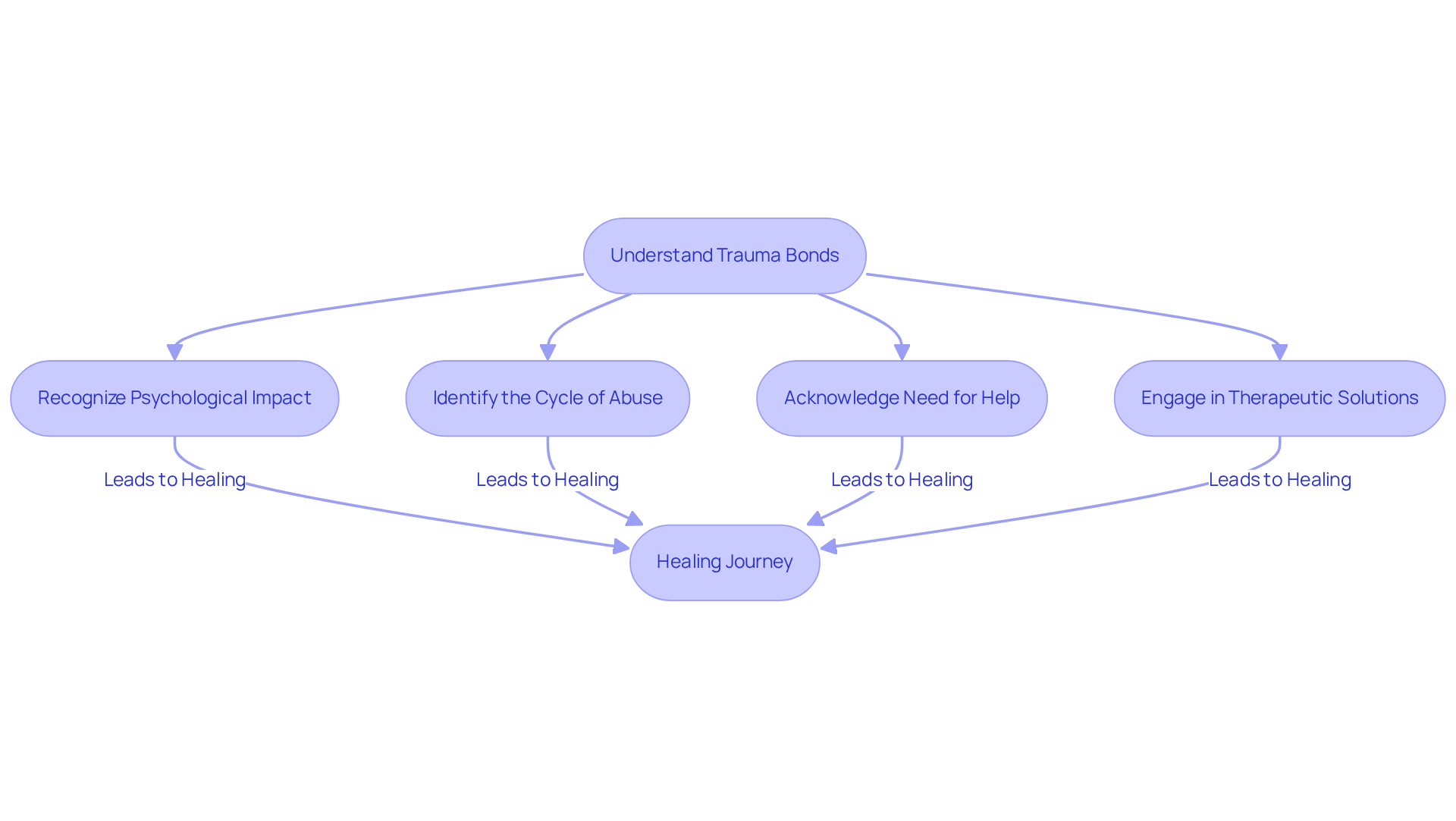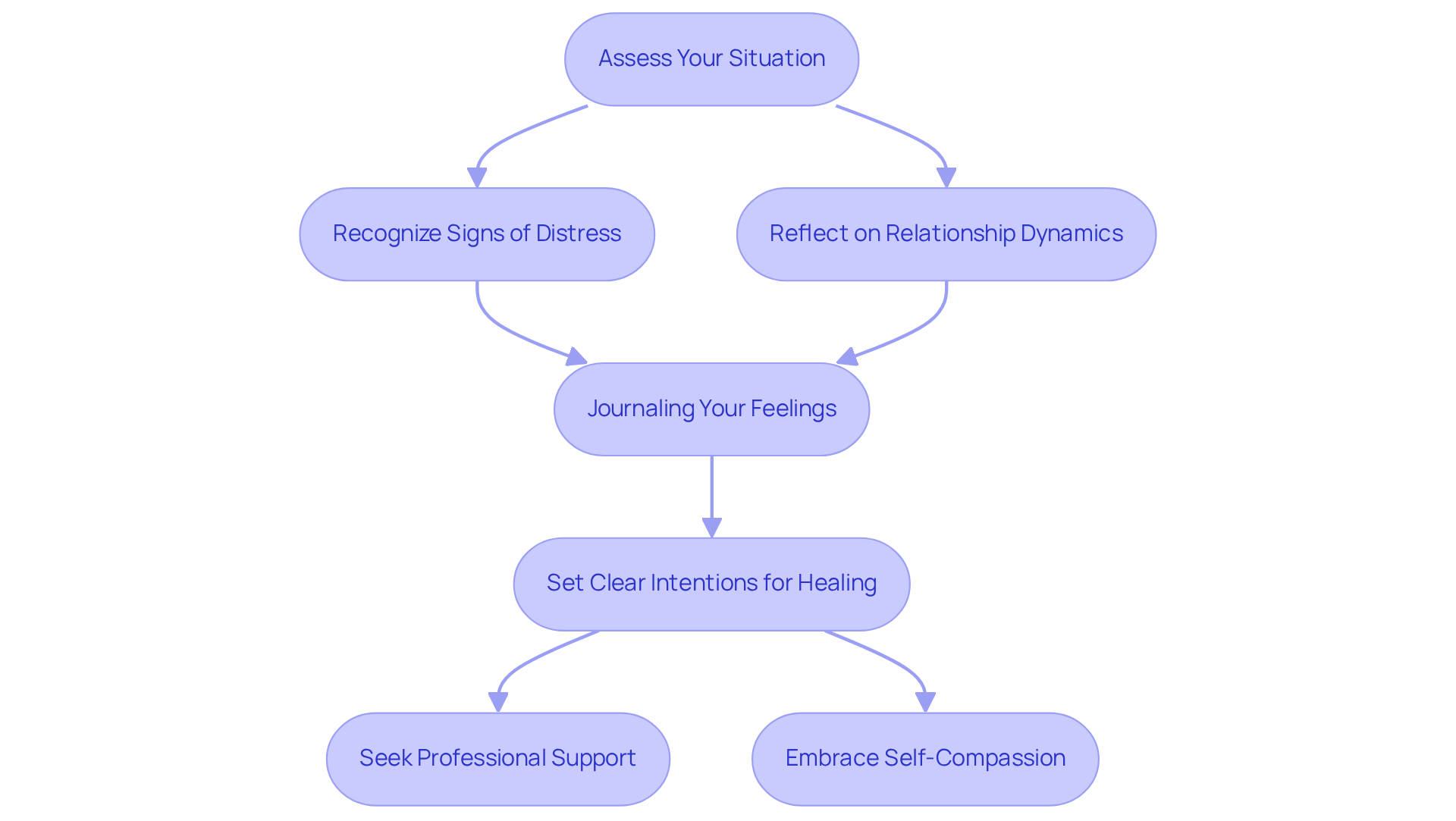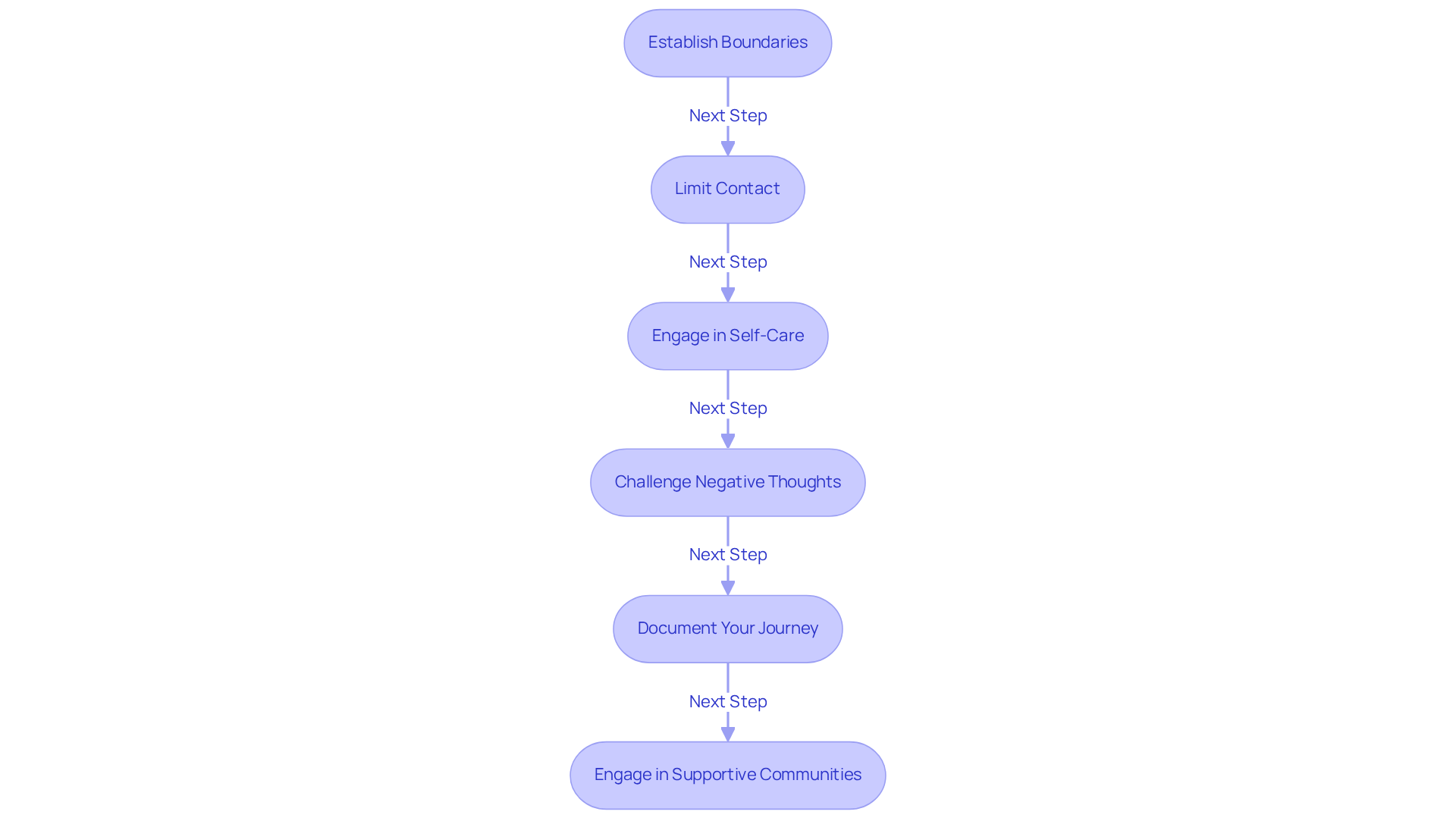Overview
This article outlines four effective steps to break trauma bonds, encouraging you to recognize harmful relationship dynamics and consider practical strategies for healing. Have you ever felt overwhelmed by your past? Understanding these dynamics is the first step towards reclaiming your mental well-being.
The methods discussed include:
- Setting boundaries
- Limiting contact with the perpetrator
- Engaging in self-care
- Utilizing therapy
Each of these strategies plays a crucial role in fostering healthier connections and nurturing your emotional health. As we explore this further, remember that seeking professional support is a vital part of this journey.
By implementing these strategies, you can take meaningful steps towards healing. It’s important to acknowledge that you deserve to feel safe and supported. Embrace this opportunity to reclaim your life and build the connections you truly desire.
Introduction
Trauma bonds create complex and often painful connections between victims and their abusers, complicating the path to healing and independence. Have you ever felt overwhelmed by your past? Understanding these bonds is essential for anyone looking to reclaim their mental well-being, as they can lead to significant emotional distress and mental health issues.
What practical steps can be taken to break free from these detrimental ties? This guide outlines effective strategies for recognizing, confronting, and ultimately overcoming trauma bonds. By empowering individuals to foster healthier relationships, we can embrace a brighter future together.
Understand Trauma Bonds: Definition and Impact
Trauma connections are intricate ties that can develop between a victim and their perpetrator, often marked by a cycle of mistreatment followed by moments of reconciliation. This dynamic creates a powerful psychological bond, making it incredibly challenging for individuals to free themselves from abusive situations. Mental health experts describe these harmful connections as detrimental attachments that may lead to significant emotional suffering, including confusion, guilt, and a reliance on the perpetrator. Have you ever felt overwhelmed by your past? Research shows that these connections can result in serious mental health issues, such as anxiety, depression, and post-traumatic stress disorder (PTSD). For instance, studies indicate that more than 90% of Vietnam veterans experience PTSD, highlighting the lasting impacts of distress.
Real-life examples illustrate how emotional attachments can form in various abusive relationships, where victims might rationalize their aggressor's behavior or feel compelled to save them despite ongoing harm. Understanding these patterns is crucial for knowing how to break trauma bond and free oneself from their grip. Recognizing how to break trauma bond caused by attachment is the first step toward reclaiming your mental well-being and independence.
At The Emerald Couch, we recognize that healing from emotional bonds often requires tailored therapy solutions designed for individual needs. Our approach includes Cognitive Processing Therapy (CPT), a structured method that helps individuals process distressing experiences and challenge unhelpful thoughts. CPT consists of four stages:
- Education about PTSD and CPT
- Processing the distress through a written narrative
- Learning to challenge thoughts related to the distress
- Addressing specific areas of life typically affected by distress
As Mike Miller, a prominent expert in emotional distress, wisely states, "To break a connection formed through distressing experiences, it is important to acknowledge the truth, be vigilant about the situation, avoid negative self-talk, and seek professional support." We also offer virtual appointments for those who may need them. By learning about the signs of emotional bonding and seeking professional assistance, you can begin to understand how to break trauma bond and foster healthier relationships.

Assess Your Situation: Recognize Signs and Prepare for Change
Begin by reflecting on your relationship dynamics. Recognizing the signs of a distressing connection is vital for your healing. Have you ever felt a deep attachment to someone who causes you pain? Common indicators include justifying their harmful actions and experiencing a rollercoaster of emotions. Journaling your feelings can serve as a powerful tool, helping you clarify your thoughts and gain insight into your experiences.
As you prepare for change, it's important to set clear intentions for your healing journey. Remember, this process may require support and courage, as it can be challenging to learn how to break trauma bond. Specialists emphasize that recognizing how to break trauma bond in abusive relationships is crucial, as many individuals feel trapped by the belief that they cannot survive without their abuser.
During this time, self-compassion is essential. As you assess your relationship dynamics, hold onto the belief that change is possible. You deserve a life free from harm. Embrace the journey ahead, and consider seeking help from professionals who can provide the guidance you need to navigate this complex emotional landscape. Your healing journey is important, and you are not alone.

Implement Strategies: Practical Steps to Break the Bond
To effectively break a trauma bond, consider implementing the following strategies:
-
Establish Boundaries: Clearly define the behaviors you will no longer tolerate. Setting healthy boundaries is crucial for self-care and positive relationships. As Jo Nash, Ph.D., emphasizes, "Setting a boundary involves clearly stating your needs or limits respectfully and assertively." You may find the 'Visualizing Your Boundaries' worksheet helpful in identifying areas of your life that need firmer boundaries; this worksheet guides you in visualizing and articulating your limits effectively.
-
Limit Contact: If possible, reduce or eliminate communication with the perpetrator. Research indicates that nearly half of participants in studies reported a reduction in PTSD symptoms after limiting contact with their aggressor. This highlights the importance of creating space for healing.
-
Engage in Self-Care: Prioritize activities that promote your well-being, such as exercise, meditation, or hobbies. Incorporating mindfulness techniques, such as breath awareness and body scans, can enhance your self-care routine. These practices help anchor you in the current moment, promoting recovery and resilience.
-
Challenge Negative Thoughts: Work on reframing negative beliefs about yourself that may have been instilled by the abuser. Recognizing and addressing these thoughts is essential for rebuilding self-esteem and confidence. Mindfulness can aid in this process by encouraging non-judgmental observation of your thoughts and feelings.
-
Document Your Journey: Keep a journal to track your progress and reflect on your feelings as you navigate this process. This practice can help you gain insights into your emotional state and reinforce your commitment to healing.
-
Engage in Supportive Communities: Connecting with supportive friends, family, or support groups can provide encouragement and validation during your healing journey. Engaging with others who understand your experiences can significantly enhance your recovery process. At The Emerald Couch, our therapists are committed to assisting you in establishing a trusting relationship, ensuring that you feel secure and supported as you navigate your challenges.
By adhering to these steps and incorporating mindfulness into your daily routine, you can learn how to break trauma bond and liberate yourself from the limitations of emotional ties, cultivating a healthier, more satisfying life.

Seek Support: Utilize Therapy and Community Resources
Connecting with a counselor who specializes in emotional distress can provide essential support as you work to free yourself from harmful attachments. At The Emerald Couch, we place a high value on fostering trust and comfort, understanding that confronting pain—such as PTSD or emotional distress—can feel overwhelming. Our trauma-informed approaches, including Cognitive Processing Therapy (CPT) and Eye Movement Desensitization and Reprocessing (EMDR), are thoughtfully designed to cater to your unique needs.
Research shows that Cognitive Behavioral Therapy (CBT) is particularly effective for those with past experiences, helping individuals reframe negative thought patterns and cultivate healthier coping strategies. As Dr. Patrick Carnes wisely notes, "You weren’t meant to do this alone," highlighting the importance of seeking support.
Have you ever felt overwhelmed by your past? If so, consider joining support groups where you can connect with others who have faced similar challenges. These groups can create a sense of community and understanding, which can be incredibly validating.
Studies indicate that individuals who establish a strong therapeutic alliance tend to experience better treatment outcomes, including enhanced stress management and more fulfilling relationships. At The Emerald Couch, we offer a complimentary 30-minute consultation to help you identify your needs and customize your therapy accordingly.
Establishing boundaries and crafting a safety plan are vital steps in understanding how to break trauma bond, ensuring that you prioritize your well-being as you navigate your recovery.
Conclusion
Breaking free from trauma bonds is a transformative journey that requires understanding, self-reflection, and the courage to change. Have you ever felt overwhelmed by your past? These bonds, formed through cycles of abuse and reconciliation, can trap individuals in a web of emotional suffering. Recognizing the nature of these connections is the first crucial step toward reclaiming personal autonomy and mental well-being.
As we explore this further, the article outlines essential steps to effectively break trauma bonds. This includes:
- Understanding the dynamics of the relationship
- Assessing personal situations
- Implementing practical strategies
- Seeking professional support
By establishing boundaries, limiting contact with the perpetrator, engaging in self-care, and documenting one’s journey, individuals can gradually dismantle the harmful attachments that have held them captive. Moreover, the importance of community and professional guidance cannot be overstated, as they provide the necessary support and validation during this challenging process.
Ultimately, the path to healing from trauma bonds is one of empowerment and self-discovery. It serves as a reminder that change is possible, and that individuals deserve to live free from harm. By taking the necessary steps and seeking the right resources, anyone can embark on a journey toward healthier relationships and a more fulfilling life. Embrace the process, reach out for support, and recognize that the journey to freedom from trauma bonds is not only achievable but also essential for a brighter future.
Frequently Asked Questions
What are trauma bonds?
Trauma bonds are intricate ties that develop between a victim and their perpetrator, characterized by a cycle of mistreatment followed by moments of reconciliation, creating a powerful psychological bond.
Why are trauma bonds difficult to break?
Trauma bonds are difficult to break due to the emotional attachments formed, which can lead to confusion, guilt, and a reliance on the perpetrator, making it challenging for individuals to free themselves from abusive situations.
What mental health issues can arise from trauma bonds?
Trauma bonds can result in serious mental health issues such as anxiety, depression, and post-traumatic stress disorder (PTSD).
How can individuals recognize trauma bonds in their relationships?
Individuals may recognize trauma bonds by observing patterns in their relationships, such as rationalizing the aggressor's behavior or feeling compelled to save them despite ongoing harm.
What steps can be taken to break a trauma bond?
Breaking a trauma bond involves acknowledging the truth of the situation, being vigilant, avoiding negative self-talk, and seeking professional support.
What therapeutic approaches are effective for healing from trauma bonds?
Effective therapeutic approaches include Cognitive Processing Therapy (CPT), which consists of education about PTSD, processing distress through narrative writing, challenging unhelpful thoughts, and addressing life areas affected by distress.
Can therapy for trauma bonds be conducted virtually?
Yes, therapy for trauma bonds can be conducted virtually, allowing individuals to access support regardless of their location.




